JERUSALEM TODAY (2014)
Map Details
After the Camp David Summit of mid-2000 failed to produce a final status agreement, partly due to
continuing disagreement between the Israeli and Palestinian negotiators on the status of Jerusalem (see
Map 59), US President Clinton outlined his position on the Jerusalem issue in his December 2000
'Parameters.' Clinton proposed an open and undivided city with assured freedom of access and worship for
all, application of the principle of "what is Arab should be Palestinian" and "what is Jewish should be Israeli,"
and that sovereignty over the Haram Ash-Sharif/Temple Mount be treated symbolically. However, the
subsequent January 2001 Taba talks also failed to bring about progress, and while the Clinton Parameters
for Jerusalem were worked out into more detail during the 2007 Annapolis process with the introduction of
an international custody scheme for Jerusalem's "holy basin," the failure of both sides to find a common
definition of the "holy basin" meant that the issue of Jerusalem was still as far from a solution as ever. During the latest rounds of peace talks (2013/14) under supervision of US Secretary of State
Kerry the issue of Jerusalem was discussed once again, but to no avail.
In July 2004, the International Court of Justice (ICJ) issued an advisory opinion to the UN General Assembly
regarding the construction of the wall in the West Bank and East Jerusalem. It reiterated that
East Jerusalem remains occupied territory, with the majority opinion of the court concluding that the route of
the wall "gives expression, in loco, to the illegal measures taken by Israel with regard to Jerusalem and the
settlements, as deplored by the Security Council," and therefore violates international law. Nevertheless,
construction has since then continued unabated and as of 2014, the projected route for the barrier in the
Jerusalem area measures some 168 km, of which only 3% lie on the Green Line.
On 13 September 2004, then mayor of Jerusalem Uri Lupolianski announced the United Jerusalem Town
Planning Scheme, known as the Master Plan 2000, which treated the city as one urban unit under Israeli
sovereignty (see Map 62). In line with the Plan’s demographic aims and despite international
condemnation, the Israeli settlement construction in East Jerusalem is ongoing, with a record high of over
2,500 new tenders approved during the Kerry peace process. East Jerusalem is dotted with
settlement projects and the settler population continues to grow steadily: while there were a little over
170,000 settlers in 2000, by 2010, their number had increased by over 15% to almost 200,000. Recent
estimates suggest that settlers in Jerusalem make up some 38% of the city’s total Jewish population.
As of 2014, about 24,500 dunums of the total 70,500 dunums of East Jerusalem land have been confiscated
for settlement construction, while only 9,180 dunums of it (or about 13%) have been zoned for Palestinian
construction. Furthermore, Israel has been pursuing discriminatory policies that make it extremely
difficult for Palestinians to acquire building permits due to high fees, long delays (up to ten years) and requirements
for proving land ownership which are almost impossible to meet. Consequently, between 2005
and 2009 only 13% of Jerusalem housing units granted building permits were in Palestinian neighborhoods.
This leaves Palestinians with two options: leaving the city or building without permission, the
municipality and the Interior Ministry encourage the former by exercising a policy of housing demolition, targeting
the unauthorized construction of Palestinians. As a result of this, over 500 Palestinian houses have
been demolished since 2004, rendering more than 2,000 people homeless, including about 1,100 minors.
The inequality between Palestinian East Jerusalem housing and services and those provided the West and
the Israeli settlements is stark and well documented. About 90% of the municipality’s 4.7 billion budget in
2011 was allocated for West Jerusalem and settlements, only 10% was spent on Palestinian residents who
make up over 36% of the city's population. Almost 90% of the city’s sewage pipes, roads, and sidewalks
are in West Jerusalem, as are about 1,000 public parks and 37 swimming pools – as opposed to only 45
parks and 3 pools in East Jerusalem. East Jerusalem has only two libraries and 33 sports facilities, while
West Jerusalem has 26 and 564 respectively. Poverty is on the rise among East Jerusalem residents: it
increased from 64% in 2006 to 79.5% in 2011 (and from 73% to over 85% for children). The comparative
numbers for Israelis were - in 2010 - 30.8% of Jewish families and 45.1% of Jewish children. With building
all but barred and services pointedly inadequate, Israel hopes to encourage migration out of the city. Its
additional policy of Jerusalem ID card revocation is one of the methods through which it is able to render
that departure permanent. As of 2014, 14,200 ID cards had been revoked from Palestinian
residents since 1967 (if their dependent children are taken into account, the number of those stripped off
their residency rights – and with it of social and health benefits – increases to over 86,000.
Other ongoing Israel policies include the expropriation of private Palestinian land and property; construction
of the separation barrier; implementation of a closure regime; and development of a transportation system
that ignores the planning interests of Palestinian residents.These measures involve further land
confiscation, hamper Palestinian development, fragment and isolate Palestinian suburbs from each other as
well as from the West Bank, and further weaken the possibility of East Jerusalem becoming the capital for
the future Palestinian state.
Related Maps
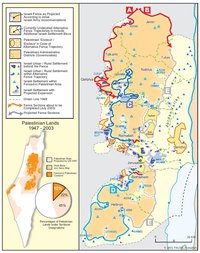
ISRAEL'S SEPARATION BARRIER, 2002
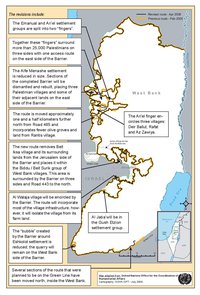
REVISED ROUTE OF THE ISRAELI SEPARATION BARRIER, 2006
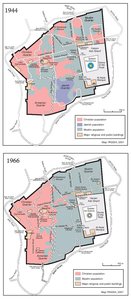
THE OLD CITY, 1944 & 1966

MUNICIPAL BOUNDARIES OF JERUSALEM, 1947-2000
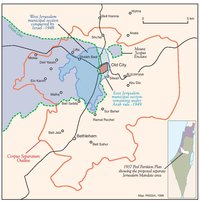
JERUSALEM AND THE CORPUS SEPARATUM PROPOSED IN 1947
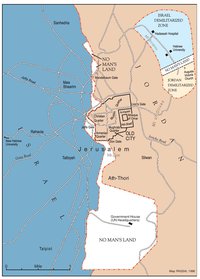
PARTITIONED JERUSALEM, 1948-1967
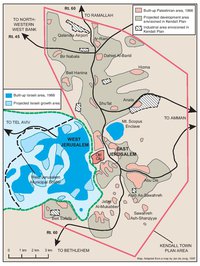
THE KENDALL TOWN SCHEME, 1966
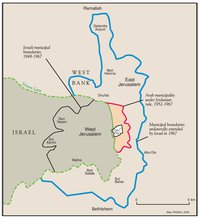
JERUSALEM AFTER THE 1967 WAR
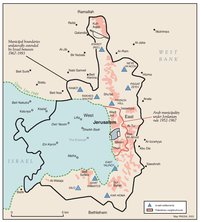
ISRAELI SETTLEMENTS AND PALESTINIAN NEIGHBORHOODS IN EAST JERUSALEM, 2000
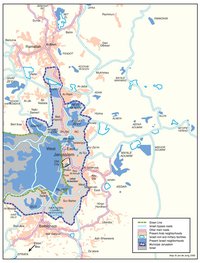
ISRAELI SETTLEMENTS AND PALESTINIAN NEIGHBORHOODS IN METROPOLITAN JERUSALEM, 2000
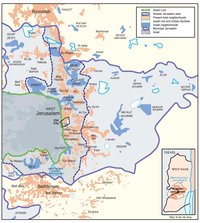
ARAB EAST JERUSALEM WITHIN ‘GREATER’ JERUSALEM, 2000

PROJECTION OF THE ISRAELI PROPOSAL FOR JERUSALEM’S FINAL STATUS AT CAMP DAVID, JULY 2000
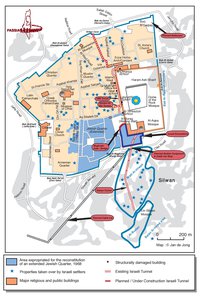
SETTLEMENT ACTIVITY IN THE OLD CITY
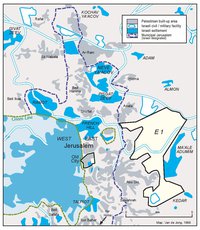
THE E-1 DEVELOPMENT PLAN
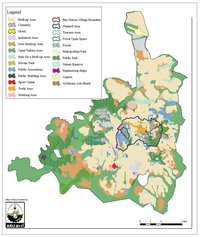
THE JERUSALEM MASTER PLAN


